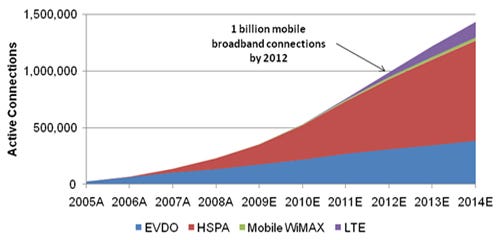January 12, 2010

One of the clearest findings from my recent Heavy Reading report, "Evolved Packet Core for LTE: Market Forecast & Competitive Analysis", is that for all the attention on Long Term Evolution (LTE) technology, it is 3G/HSPA that will power the mobile packet core market over the next few years.
This mobile broadband subscriber chart, based on forecast data from our sister company Pyramid Research , shows why:
It's that large, red swath of HSPA subscribers (the UMTS R99 version of 3G is not included on the chart) that's really going to drive the need for investment in the core. And even though unit costs would ordinarily decline on the volume growth, the fact that each subscriber will be using more data, and more advanced applications, will serve to support price-per-subscriber over the forecast period. Taken together, this should enable the market to grow at a decent pace over the next few years, to be worth approximately $2 billion by 2012. (See also Evolved Packet Core for LTE and LTE Core Action Heats Up.)
So what does this forecast investment in the 3G/HSPA core mean for Evolved Packet Core (EPC) and LTE?
The answer could lie in the concept of a common core for 2G, 3G, and LTE, and the capability to configure the network in software to support each radio access technology. This is easier said than done, of course, and there's no doubt that vendor marketing tends to overstate the case. But there is nevertheless an opportunity for a software-based common core strategy.
Operators deploying new packet core equipment to support 3G/HSPA growth from 2010 onward now have enough visibility into EPC requirements, and the products themselves are powerful enough that investment can be made in 3G today, with a view to potentially upgrading to EPC later.
It is this requirement that resulted in the shake-out of GGSN platforms in 2009, to the point where there have really only been three competitive players – Starent Networks Corp. (Nasdaq: STAR), Ericsson AB (Nasdaq: ERIC), and Huawei Technologies Co. Ltd. – able to credibly sell this approach to operators. Vendors with lower-performance platforms, or those without an obvious upgrade to EPC, have suffered in 2009 and have had to accelerate development of new, future-proof hardware platforms.
The appeal of this software strategy is that the market is still at the "knee of the curve," and therefore vendors that can establish a footprint in the HSPA core have a great shot at ongoing success in EPC. In this sense, claims of "your 3G core is also your LTE core" are plausible. Similarly, vendors attempting to use EPC as a point of market entry or expansion must also support 2G/3G applications, and in particular the GGSN, as they too will need a "common core" story.
For operators, whether the 3G-to-EPC transition via software upgrade is a definitive strategy decision or more of a just-in-case insurance policy depends very much on the timing of LTE rollout and expectations for ongoing growth in 3G. It can't hurt to cover both angles.
— Gabriel Brown, Senior Analyst, Heavy Reading
For more information about Heavy Reading's "Evolved Packet Core for LTE: Market Forecast & Competitive Analysis," or to request a free executive summary of this report, please contact:
Dave Williams
Sales Director, Heavy Reading
858-485-8870
[email protected]
Read more about:
OmdiaYou May Also Like


_International_Software_Products.jpeg?width=300&auto=webp&quality=80&disable=upscale)







